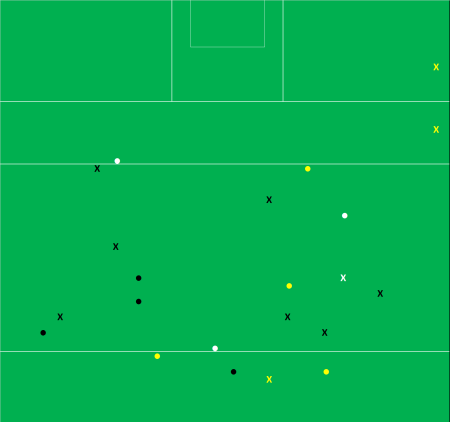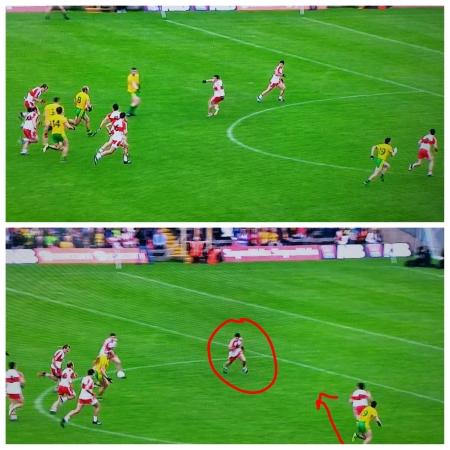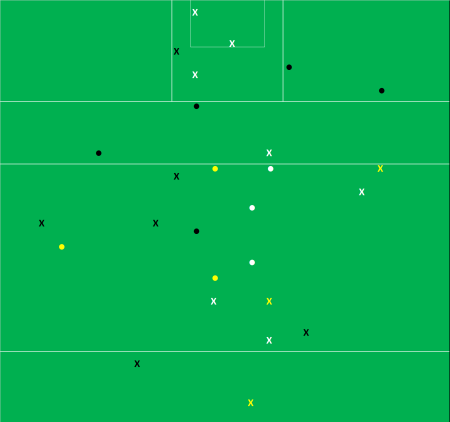Below is a quick overview of some of the more interesting numbers coming out of this year’s league. When listing individual teams, under any specific metric, note that it will be confined to those teams with at least three games played (see NOTE1)
Possessions
Team Possessions

11 games covered which equates to 22 returns – of which Galway have the three performances with the least amount of possessions. Not just the three lowest though – their two games against Donegal and Mayo are a full six possessions lower than the next lowest recorded by any other team. Intriguingly it is not that they are completely slowing games down and “dragging” the opposition down with them. They have easily lost the possession battle in all three games; by totals of 6 (v Kerry), 7 (v Mayo) and 8 (v Donegal).
Player possessions

That impression you have of Dublin dominating possession? Yeah it is not merely an impression. Of all team possessions with 20 or more player possessions (essentially player touches or strings of passing) Dublin have six of the top 11 and are the only team to top 30 player possessions in the one move.
Offensive production
Team

Perhaps surprisingly Dublin are not the most prolific offensive team in terms of output. They are below the average in the number of shots per game and shots per possession they attempt. What they lack for in quantity they more than make up for in quality however. They have a wonderfully high Conversion Rate on the shots they do take. Alloy this Conversion Rate, with the high volume of possessions, and you get your high scores.
Galway are highly proficient when they attack (high shots per possessions and Conversion Rate) but as noted above their (current) weakness could be the inability to create enough shots, through low possession counts, should the radar be off.
Donegal are shooting from everywhere with near on 30 shots per game – but their relatively low Conversion Rate is indicative of the fact that a lot of these are from “outside” the shooting zone.
Kerry’s new forward unit with O’Sé, Burns & Clifford are chugging along nicely whilst Mayo are struggling.
Player – shooting

The above table shows all players with at least 8 shots from play (see NOTE2).
Brannigan is currently on fire scoring 2 – 06 from his 10 shots as is McBrearty’s left peg (all 13 shots are point attempts with the left). Noticeable how these two are then followed by a squadron of Dublin attackers. This is to be somewhat expected given Dublin’s 65% Conversion Rate as a whole but it is still striking when you see that they have five of the top7 shooters by Expt Pts.
Player – assists
So this is new. I have started to track assists as another tool to view the front 8. This is somewhat subjective as a number of shots will come from players themselves making the breakthrough thus not producing an assist; or a defender might foul the ball thus providing the opposition with a shot from a free (does the player who induced the foul get an assist?); or the last pass may be an incidental popped hand pass (see NOTE3). As with any new metric there’ll have to be an element of trust on this one!
Unlike the shooting, which can have a positive or negative Expt Pts depending on whether the shots were converted, assists can only have a positive Expt Pts as the Expt Pts will relate to the point attempt rather than the shot outcome. But what we can do is plot the Expt Pts for shooting versus the Expt Pts for assists and get a more complete picture of a player’s offensive involvement

The above chart shows the shooting/assist Expt Pts interplay for those players listed previously with at least 8 shots from play. Where you want to be is in the top right quadrant (highlighted by the green circle) with a high positive Expt Pts for shooting (thus being very accurate) and a high Expt Pts for assists (thus showing a high level of attacking involvement).
Can we consider Fenton a midfielder? These offensive numbers are off the chart – high volume of shots, with high accuracy and high assists production. On his assists he has won three frees that led to Dean Rock attempts at goal, set up Kilkenny for his goal against Tyrone and also provided the assist for seven point attempts. Phenomenal.
McBrearty has two less assists than Fenton (9 v 11); he also has won three frees (that he himself took) but has set up two goal attempts and four point attempts.
Given his accuracy from play (0 – 09 from 13 point attempts) and the fact that he is Donegal’s main free taker (0 – 17 from 20; 85% Conversion Rate and +0.8 Expt Pts) it is some feat to also be so high on the assist chart. He is a very different player to Fenton but currently no less phenomenal.

The only problem with the first chart is that it hides the “non shooters”. Purely listing by the volume of assists we see the likes of A O’Shea, P Conroy and S O’Sé start to rise to the top.
Defensive production

Again perhaps surprisingly Dublin do not show up as best in class here. They allow more shots per possession than anyone else which, allied to their more open games, leads to more shots allowed per game than anyone else. What is noticeable however is the low quality of the opposition’s shooting (Conversion Rate at a very low 45%).
This low Conversion Rate can undoubtedly be attributed to excellent defending (more pressure on the shooter and/or teams taking shots from less favourable positions) but there must also be a mental aspect to this – teams forcing attempts knowing they have to keep up.
The argument against this is perhaps Galway. Their defensive numbers are very similar to Dublin’s yet it would be hard to argue that teams are under the same mental pressure when facing Galway as they are when facing Dublin.
I would contend however that Galway defend differently – tighter, more aggressive – and it is this that gives them the same defensive edge that Dublin seem to gain from their opponent’s mentality. Still it is definitely something worth looking at after the league – do teams shoot differently against Dublin as opposed to against anyone else?
On the offensive summary we commented on Kerry & Donegal’s higher numbers which was a nod to the fact that they had a good balance in attack (Kerry) or a defined game plan (Donegal could be deemed “shoot on sight”). They are both struggling on the back end however.
Kickouts
When looking at these tables it is again important to reference NOTE1 below – any changes may be as a consequence of natural differences between league and Championship rather than wholly attributable to the changes in the kickout rules.

Having said that there has definitely been a change in kickouts with the proportion of kickouts going short (landing inside the 45m line) dropping from 48% in the 2017 Championship to 37% this league campaign. That’s dramatic enough and the sample size – at 28% of the 2017 Championship games – is representative. Come the end of the league we can expect the proportion of short kickouts to have dropped by c10%.
We have seen Marks increase but not to any great degree. Instead we are back to the future where breaking ball is becoming more important. I define such kickouts as “contestable” (outside the 45m line and not claimed through a Mark – see NOTE4).
Kickout teams have increased the proportion of “contestable” kickouts they win but in both the 2017 Championship & 2018 League campaigns teams only manage to win c50% of their own “contestable” kickouts.

There are some interesting titbits looking at kickouts by team
Galway weren’t as fond of the short kickout as others in 2017 but have almost eschewed it completely so far with only 14% going short (remember the average is 38%). Given that the kickout team gets the ball ~95% of the time when it goes short this also explains why they are losing the possession battle as noted earlier (as does the fact that they are below average in winning their own “contestable” kickouts).
Donegal’s drop off is as pronounced (60% of kickouts in 2017 Championship went short versus 25% in the 2018 League) however this could be attributed to a change in philosophy under Declan Bonnar as much as anything else.
Dublin’s short ones have dropped off completely (66% in ’17 down to 44% thus far) – getting ready for the Summer perhaps when they expect a high press from the opposition? Also noticeable that despite their athleticism, and Cluxton’s radar like aim, they are only average on “contestable” kickouts.
Mayo & Kerry appear to have completely ignored the new rule (playing possum and not showing their Summer hand?). Kerry have been very good on their own kickout claiming a high of 69% of their own “contestable” kickouts.
Notes
Note1; 11 Division1 games in total. All shown on TV so any bias can be aimed at TG4 and/or EIR! Only Division1 game not completed thus far is Monaghan-v-Tyrone
Where there are comparisons to 2017 Championship numbers it is worth noting that we have no real previous comparisons between League and Championship campaigns. There has always been the sense that the League will be different but we just don’t know (I have been particularly lazy in not doing league campaigns before!).
This point, that there may be a natural difference between League & Championship, is particularly important when we come to kickouts as we have the additional overlay of the new kickout rules. Just because numbers change here does not mean it is as a direct result of the law changes – there may also be a natural difference between League & Championship outputs.
Note2: As an aside this shows the problem with judging players through their shooting. Even the most prolific shooter – McBrearty at 13 shots in three games – has a very small sample size
Note3; I have ~84% of shots not having an assist.
Note4; acknowledging that not all kickouts past the 45m line are contested – nor indeed that all Marks are un-contested. Still – it’s an easy label.







































